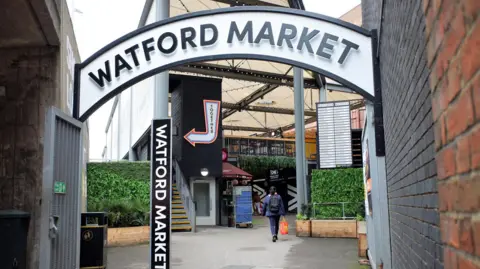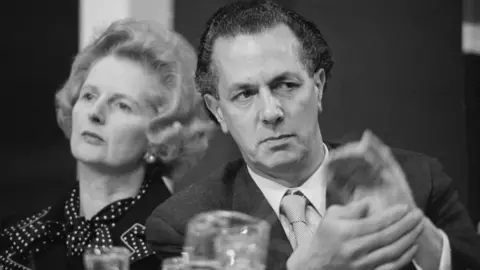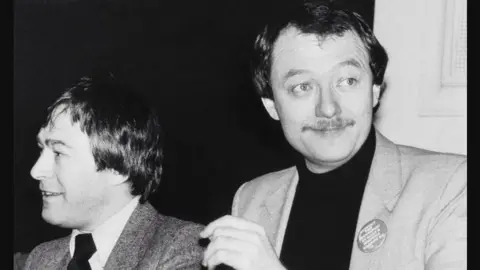How London's boroughs were named 60 years ago
 Getty Images
Getty ImagesEver heard of the London borough of New River? It doesn't exist, but it nearly did.
On 1 April 1965 the local government map of London was set, with the establishment of the 32 boroughs that still exist today.
Along with the City of London these boroughs tell others a lot about where we live, but also come with prejudices and assumptions about what they are like.
Ahead of the 60th birthday of Brent, Bexley, Barking, Barnet and all the boroughs that don't begin with the letter B, we look back at how modern London was born.
No 'and' boroughs
Once the boundaries were settled, via the London Government Act 1963, the clock was ticking.
These 32 new boroughs were due to be born on 1 April 1965.
What were they to be called? Rivers, bridges, mis-spellings and the long-standing military responsibilities of ancient parishes would all feature.
The local government minister, Sir Keith Joseph, who would later become well-known as the intellectual father of Thatcherism, stipulated that there would be no 'and' boroughs.
The merger between Wanstead and Woodford would be resolved with a new name – Redbridge.
Wanstead and Woodford was not an option.
Wandsworth was able to continue basically as it was, while Wembley found itself joined to Willesden, two areas that even in the 1960s had little in common.
They were merged into Brent, named after a river that runs through the borough.
Feltham, Heston and Isleworth, and Brentford and Chiswick councils chose none of those five potential names and became Hounslow instead.
Tower Hamlets is a nod to parishes near the Tower of London that owed military service to the Constable of the Tower.
Today the borough extends as far as Canary Wharf.
Haringey simply defies explanation, with the merger of Hornsey, Tottenham and Wood Green being named after a small part of the new borough that's actually called Harringay.
According to YouTuber and popular historian Jay Foreman, whose video about the formation of the London's local government has more than 6.7 million views, three of the new boroughs wanted to be called Riverside, including one that wasn't even on the Thames.
Most chose one of their existing names, so for example the merger of Southgate, Enfield and Edmonton became Enfield.
Enfield Chase and Edmonton Hundred were both rejected.
East Ham and West Ham became New Ham – Newham.
Clapham and Streatham became Lambeth.
East Barnet, Friern Barnet, Hendon, and Finchley were merged into a single borough called Barnet.
Which name was judged more historically important also played a role.
Richmond and Twickenham warred over which one should be supreme – Twickenham lost.
Chelsea managed to persuade ministers that "Chelsea" was such an important historical name that the no "and" rule should be broken.
Thus the Royal Borough of Kensington and Chelsea was the only one of the 32 boroughs created in 1965 with an "and".
Later legislation allowed for the creation of Barking and Dagenham, and Hammersmith and Fulham.
 Getty Images
Getty ImagesAnd New River? That was the proposed name for the merger between the metropolitan boroughs of Finsbury and Islington.
New River was Finsbury's preferred name. Islington thought the name Islington would be better.
Islington Borough Council it was.
The reorganisation began with a Royal Commission on Local Government in Greater London, also known as the Herbert Commission, was which established in 1957.
Its final report was published in 1960 recommended radical change - the Greater London area was a messy mix of inner and outer London.
In inner London were the metropolitan boroughs, many based on ancient parishes like Shoreditch, St Pancras, Hampstead and Kensington.
Further out were a mix of county and municipal boroughs and urban districts which all had different functions and responsibilities.
The Herbert commission proposed 52 greater London boroughs with a population range of 100,000 to 250,000, to be achieved by merging some authorities, which would mean taking bits of other counties into London.
Among the towns surrounding the capital that could have been within the boundary of greater London were Chigwell in Essex; Esher, Walton and Weybridge in Surrey, and Watford, Elstree and Bushey in Hertfordshire.
Local government minister Sir Keith Joseph changed the plans, proposed 34 boroughs and set out the boundaries.
That had been reduced to 32 by the time the bill passed through Parliament in 1963.
 Getty Images
Getty ImagesA new Greater London Council (GLC) was also created on 1 April 1965, responsible for citywide services such as fire, ambulances and flood prevention.
The London boroughs took over services such as social care, libraries and cemeteries.
The inner London Education Authority (ILEA) took responsibility for schools in the 12 inner London boroughs.
The 20 outer London boroughs became individual education authorities.
The GLC was abolished by Joseph's protégé Margaret Thatcher in 1986, and ILEA was gone by 1990.
It would take the election of a Labour government to revitalise some modicum of central control to the capital.
In 2000 the first Mayor of London was elected and the Greater London Assembly was established.
 PA Media
PA MediaAnd just like the old GLC, the leader (now called the mayor) was Ken Livingstone.
Sir Keith Joseph set out his vision for London when the legislation was being debated in 1963.
He said it was essential that the new boroughs "should be based on a natural focus to carry out those duties and to evoke the necessary loyalties. This is the very opposite of bureaucracy. We are taking this step because we are trying to make a potential community for the people of Greater London".
Sixty years on, whether or not council tax payers do have "the necessary loyalties" to their borough, it is a useful marker of where in London you live.
From Hounslow to Hackney, Havering to Haringey, your borough says a lot about what community of London you live in.
Listen to the best of BBC Radio London on Sounds and follow BBC London on Facebook, X and Instagram. Send your story ideas to hello.bbclondon@bbc.co.uk
